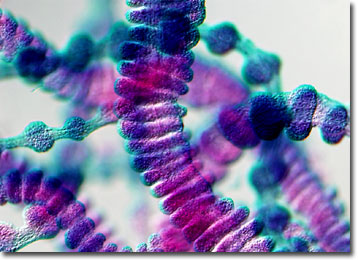Differential Interference Contrast Image Gallery
Jellyfish Sensory Organs (Aurelia Tentaculocysts)
Despite their common name, jellyfish are not fish at all, but are rather cnidarians that have a medusoid, or bell-like, body shape. The jelly, or mesoglea, in scyphozoan jellyfish is thick and surprisingly firm to the touch considering the substance is composed of approximately 90 percent water.

Aurelia is a genus of scyphozoan jellyfish whose members can commonly be seen floating in coastal waters. Though they do not have eyes or ears, the marine invertebrates do possess sensory organs that allow them to detect light, chemicals, and touch. Moreover, the medusae feature reduced and modified tentacles, known as tentaculocysts, along their margins, which contain hollow sacs called statocysts that maintain equilibrium. If the jellyfish becomes tilted out of its normal swimming axis, the tentaculocysts are stimulated and the statocyst in the highest position leans in such a way that rapid nerve impulses are created. In turn, the stimulated nerve endings cause the muscles of the jellyfish to contract, correcting its position in the water.
One of the jellyfish most familiar to humans is the moon jelly, scientifically known as Aurelia aurita. The species is easy to recognize because of the four round, or horseshoe-shaped, reproductive organs that can be clearly seen through their transparent pink or bluish hued bodies. The tentacles of moon jellies are short and fringelike, and their sting is much less toxic than many other types of jellyfish. Also, the stinging action of their nematocysts is not powerful enough to pierce the thick skin of humans, though they can occasionally catch small aquatic animals. Most of their food is instead gained by trapping plankton in the layer of mucus that coats their bells.
